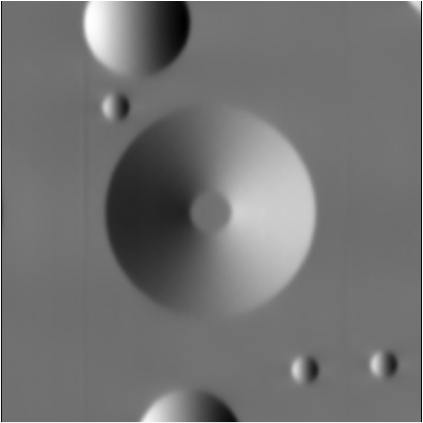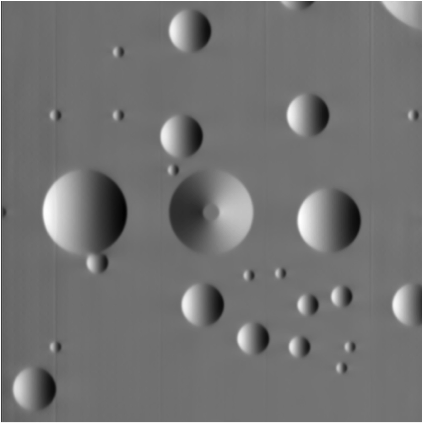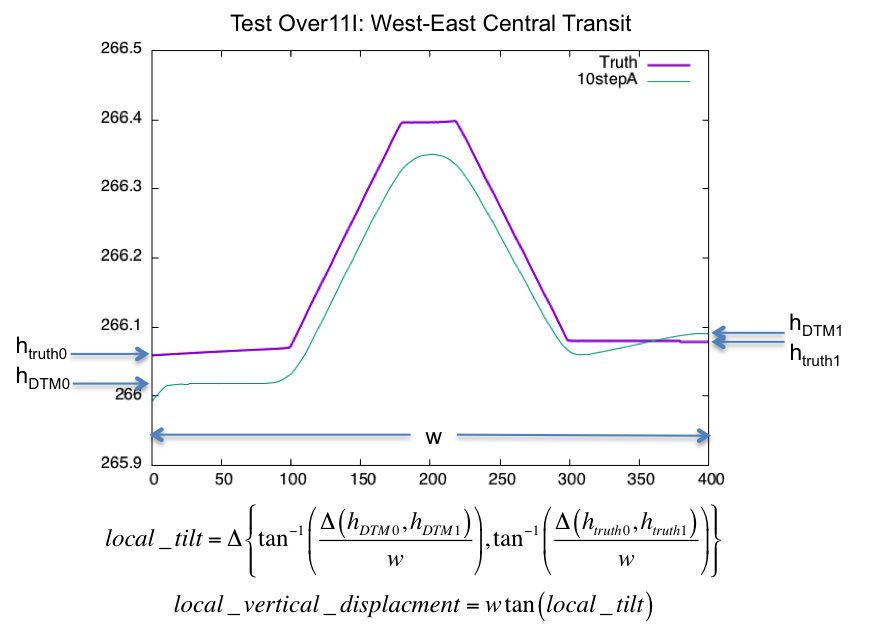Reference Peak
Local Tilt Investigation
Aims and Objectives
Purpose of test: To investigate the magnitude and mechanism of local tilting of the DTM with respect to the truth topography in the region of the reference peak.
Additional Objectives:
- Investigate the effect of the order in which overlap corrections are applied to maplets;
- Consider the vertical-error introduced by local tilt;
- Calculate the relative magnitudes of tilt and induced vertical error with image resolution and maplet ground sample distance;
- Study a larger evaluation area centered on the peak and containing multiple peak and crater features;
- Compare tilt behavior across tests, comparing results for test Over11I against Over11S, T and U, the spacecraft zenith variation test suite.
Background
A local tilt in the region of the reference peak is apparent upon inspection of the DTM, specifically the 4mx4m bigmap which is centered on the peak. Furthermore, tilt of bigmaps with respect to truth topographies has been observed across SPC tests. The purpose of this investigation is to measure the magnitude and direction of tilt through tiling and iterating steps and to explore the mechanism by which the DTM tilts with respect to the truth topography.
A possible source of systematic error and tilt is the procedure for updating the solution of a single maplet by considering the local solutions of all overlapping maplets and applying an 'overlap correction' or 'overlap constraint'. The standard procedure for tiling bigmaps and iterating maplets with regards to overlap correction is as follows.
Tiling a bigmap:
- The region in which the bigmap is contained is tiled with a suite of new maplets which will have a ground sample distance smaller than (higher resolution than) the ground sample distance of the existing maplets contained in the bigmap area.
- Center coordinates for the new maplets are generated based on the maplet ground sample distance, the Q size, and the overlap percentage.
- Starting from the North-West-most maplet center coordinate, the first new maplet is created.
- Images are added, eliminated and registered for the new maplet. The photoclinometric solution is generated, conditioned using differential stereo and used to update the topographic model. A stereogrammetric correction is then applied causing adjustment to heights and location of the maplet. The overlap correction is then generated by considering the existing local height and slope data of all overlapping maplets. During tiling, the overlapping maplets are the pre-existing higher ground sample distance (lower resolution) maplets.
- The maplet center coordinate immediately to the East of the first new maplet is then used to create the next new maplet.
- Again, images are added, eliminated and registered, the photoclinometric solution is generated and conditioned using differential stereo, a stereogrammetric correction is applied, then the overlap correction is applied. Now the overlapping maplets will include the first new maplet, which overlaps only along one edge of the new maplet.
- This procedure continues until the Northernmost row of new maplets have been created, solved and overlap corrected.
- The process is then repeated to create the row of maplets immediately South of the Northernmost row of new maplets.
- Tiling is complete when the South-Eastern-most new maplet has been generated.
- As new maplets are created, their names are appended to USED_MAPS.TXT.
Iterating the maplets contained in a bigmap:
- The maplets are processed in the order in which they appear in USED_MAPS.TXT, i.e. the order in which they were created. Thus each GSD suite of maplets is iterated in turn, starting from the highest Ground Sample Distance (lowest resolution) suite and ending with the lowest GSD (highest resolution) suite. The maplets in each GSD suite are iterated from the North-Western-most maplet to the South-Eastern-most maplet in rows traveling West to East.
- For each maplet, the images are registered, the photoclinometric solution is generated, conditioned using differential stereo, and used to update the topographic model. The overlap correction is then generated by considering the existing local height and slope data of all overlapping maplets. During iterating, the overlapping maplets will include iterated higher GSD (lower resolution) maplets, the not-yet-iterated lower GSD maplets, iterated same-GSD maplets to the North and West of the maplet, and not-yet-iterated same-GSD maplets to the East and South of the maplet.
This study therefore intends to investigate the contribution of the order in which overlap corrections are applied to the tilt local to the reference peak, calculate the magnitude and direction of tilt at various GSD tiling and iterating steps, calculate the vertical displacement introduced by tilt and observe systematic error in a larger evaluation area around the reference peak.
Methodology
Test Over11I was chosen for the investigation since it has been the focus of user-to-user and server-to-server repeatability and has a low number of images, enabling relative speed in processing.
The following tests were conducted:
Baseline: Test Over11I tiled at GSD of 10cm and 5cm. Iterated 100 times at GSD of 5cm.
Repeat: A same-user, same-server, equal-numnber-of-core-processors repeat of the baseline test Over11I was conducted to obtain a measure of uncertainty.
Backwards Tiling/Iterating: The baseline test was re-run with the only difference being the order in which maplets were tiled and iterated. The standard order was reversed; maplets were processed starting with the South-East-most maplet, traveling East to West along each row, finishing with the North-West-most maplet. (There was no change in the order in which GSD maplet suites were processed; as per standard processing, maplet suites were processed starting with the highest GSD (lowest resolution) maplets and finishing with the lowest GSD (highest resolution) maplets.
Higher Resolution Tiling: The Baseline and Backwards Tiling/Iterating Tests were tiled at lower GSDs, starting from the last tiling step, thus their processing steps were: Tiled at 10cm, 5cm, 2cm, and 1cm, with no iterations.


Images, from left to right, 4m x 4m bigmap centered on the reference peak, and 10m x 10m bigmap centered on the reference peak.
Two evaluation areas were used to obtain CompMapVec heat plots, central transits and statistics, as illustrated above. The 4m x 4m evaluation area is consistent with the full suite of Over11 Reference Peak test evaluations. An additional 10m x 10m area centered on the reference peak was evaluated in order to consider systematic errors, tilt and relative statistics for a larger landscape around the reference peak which contains multiple peak and crater features. As per the Over11 test suite, the evaluation area ground sample distance was 1cm across tests.

The magnitude of local tilt was calculated from the heights at the edges of the 4m x 4m bigmap and truth model central transits running due North and due East as illustrated in the above diagram. Local tilt therefore refers to the tilt of the underlying DTM landscape with respect to the truth landscape extending only 2m from the center of the reference peak.
The local tilt induced vertical error was calculated by obtaining the vertical displacement due to tilt across 4m, as illustrated in the above diagram.
Results and Discussion
Repeatability
The results of the repeatability test are stored here: Local Tilt Repeatability Results
The Over11I baseline and repeat test demonstrate high repeatability:
CompMapVec, Compare OBJ and Compare OBJ with Optimal Translation and Rotation RMSs repeat within 2% for tiling steps and early iterations, and repeat within 7% beyond 10 iterations;
- Formal Uncertainties repeat within 1% for tiling steps, but demonstrate a much higher variability through iterations with repeats falling within 30%;
- Baseline and repeat heat plots and central transits are indistinguishable from one another.
The differences in formal uncertainty, RMSs and tilt reported herein are therefore due almost entirely to the order in which the maplets are processed and overlap constraints applied.
Dynamic Tilt Behavior
To view animations illustrating the dynamic tilting over tiling and iteration steps, please follow the links:
Local Tilt Heat Plot Animations
Local Tilt Central Transit Animations
The static images are stored here:
The dynamic tilt behavior is different depending on the order by which the maplets have been processed and overlap constraints applied.
For both the standard ('forwards') and the 'backwards' tiled/iterated tests, 10cm tiling results in a significant tilt across the 10m evaluation area which decreases with lower GSD tiling and iteration, although the entire DTM surface drifts vertically, away from the truth.
Interestingly the direction of tilt comparing the standard (forward) and backward tiling/iteration results is broadly similar West to East but not consistent North to South, but not opposite in direction as would perhaps be expected given the reversed order of processing maplets and applying overlap constraints.
In terms of the central transits, the West-East central transits for standard (forward) and backward tiling/iteration are not dissimilar, with differences in tilt magnitude after the 10cm and 5 cm tiling diminishing through iteration to reach near-conformity by 50 iterations. The North-South transits however remain dissimilar in tilt magnitude and direction throughout the 10cm and 5cm tiling and iteration steps.
Tilt is no longer visible for the 2cm and 1cm tilings and the standard (forward) and backward tiling/iteration tests demonstrate close conformity.
Dynamic tilt behavior is also recognizably similar across tests Over11I, S, T and U, which differ only in the number of images and the viewing conditions.
Magnitude of Tilt and Scalability with DTM Ground Sample Distance
The results of the tilt magnitude and vertical displacement calculations are stored here: Local Tilt Magnitude Results
Test Over11I Standard (Forwards) and Backwards Tiling/Iterating:
North-South transit local tilt: The direction of tilt is opposite for the forward and backward tiling/iterating tests throughout tiling and iterating steps.
Forwards Tiling/Iterating: Tilt increases from near-zero at the 10cm tiling step to to -0.5° at the 5cm tiling step, oscillates around -0.4° throughout 5cm iteration, and resolves to near-zero at 2cm and 1cm tiling steps.
Backwards Tiling/Iterating: Tilt decreases from 0.6° at the 10cm tiling step to 0.3° at the 5cm tiling step, decreasing slowly throughout 5cm iteration to near-zero, but only decreases to 0.2° with 2cm and 1cm tiling steps.
West-East transit local tilt: The direction of tilt is the same but the magnitude different for the forward and backward tiling/iterating tests throughout tiling and iterating steps.
Forwards Tiling/Iterating: Tilt decreases from -0.7° at the 10cm tiling step, to -0.4° at the 5cm tiling step, resolves to zero throughout 5cm iteration, only becoming non-zero (0.2°) at the 1cm tiling step.
Backwards Tiling/Iterating: Tilt decreases from -1.2° at the 10cm tiling step, to -0.6° at the 5cm tiling step, resolves to -0.2° throughout 5cm iteration and the 2cm and 1cm tiling steps.
The magnitude and direction of tilt through tiling and iterating steps is broadly similar across tests Over11I, S, T, and U. Tilt magnitude and direction is therefore related to neither the number of images nor the viewing conditions.
The local tilt magnitude and the induced vertical displacement across 4m scales with DTM ground sample distance as follows:
10cm tiling: local tilt (local gradient error) of up to 2.2°, induced vertical displacement of up to 15.0cm.
5cm tiling: local tilt (local gradient error) of up to 0.6°, induced vertical displacement of up to 4.0cm.
5cm iteration 50: local tilt (local gradient error) of up to 0.4°, induced vertical displacement of up to 2.4cm.
2cm tiling: local tilt (local gradient error) of up to 0.2°, induced vertical displacement of up to 1.0cm.
1cm tiling: local tilt (local gradient error) of up to 0.2°, induced vertical displacement of up to 1.0cm.
Evaluation Statistics: Standard (Forwards) vs Backwards Tiling and Iterating
Link to charts: Local Tilt Stats
Discussion.
10m Evaluation Area Statistics
Link to charts: 10m TAG vs 4m Peak Stats
Compare statistics between the 4m peak site and the 10m site, centered on the peak.
Conclusions and Recommendations
Uncertainty in instantaneous gradients in the DTM should be considered as part of the assessment of the Stereophotoclinometry software suite for OSIRIS-REx safety-mapping and TAG site selection.
Local tilt errors have been measured as part of this investigation for a artificial, simplified terrain containing peaks with 20deg slopes and various-sized parabolic craters. The tilt magnitude (of the DTM with respect to the truth topography) and induced vertical displacements have been found to scale with the ground sample distance of the DTM. Local gradient errors (as measured across 4m) have been found to be small (<0.4° at a DTM GSD of 5cm) and the induced vertical displacements within the vertical uncertainty found in similar tests (<4cm at a DTM GSD of 5cm). However, gradient errors measured across a smaller distance may be greater and it is not clear how dependent the local tilt behavior is on the local terrain and topographic features.
The order in which maplets are processed and overlap corrections applied causes significant changes to the dynamic behavior of the DTM tilt with respect to the truth topography and the magnitude of local gradient errors and vertical displacements.
By altering the order and manner in which maplets are processed and overlap corrections are applied, it may be possible to decrease the systematic errors which are undoubtably influencing the nature and magnitude of local tilting of the DTM with respect to the truth topography. Two specific recommendations are put forward in this regard:
- The maplets may continue to be processed in the current standard order, however overlap corrections should not be applied until after the entire suite of maplets has been processed using stereophotoclinometry. This can be achieved by tiling/iterating the maplets in two distinct stages. First processing the maplets, then applying overlap corrections to each maplet.
- Overlap corrections should be applied to maplets in a random order which changes from processing step to processing step. Errors will certainly remain, but will be more randomly distributed and less amenable to systematic propagation through the DTM.
